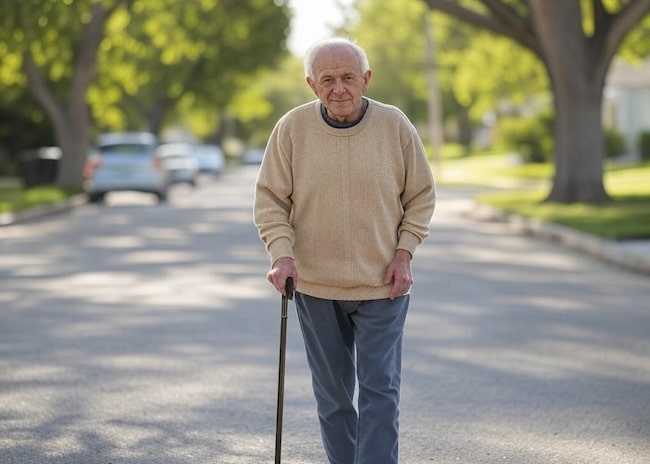Caregiving is a marathon of details—appointments, medications, mood changes, and to-dos—all swirling in your head while you try to stay present for your loved one. A well-organized caregiver notebook can be your lifeline, transforming chaos into clarity while protecting your mental bandwidth.
These two easy-to-use templates (one for daily logs, one for emergency info) help you track what matters most, spot patterns over time, and share critical updates with doctors or family, all while freeing up space in your mind to breathe. Less stress starts with writing it down.

Reduce Caregiving Stress with a Notebook
Did you know that keeping a caregiving notebook can help reduce stress? As a caregiver, you manage various aspects of an older adult’s life. One of the most critical activities is eating, taking medications, bathing, toileting, managing pain, and other essential daily tasks.
Trying to remember what was done, any problems that came up, or what still needs to be done adds another layer of pressure and clutters your mind. Writing this information down in a notebook dedicated to caregiving takes it out of your overloaded brain.
Caregivers Keep Too Much Info in Their Heads
On a typical day, you might be trying to remember if you already gave your senior their mid-morning dose of medication or if you got distracted by a big mess they made at 10:15 a.m. and forgot to give it at all.
Then, you might wonder, when was the last time they bathed? Was it Tuesday or Thursday? Shoot, the doctor’s appointment is coming up soon. There were a few days when they had a sharp pain in their side. You know the doctor will ask for more details when you tell them about it. But was it last week or the week before? And wasn’t there something else going on when the pain started?
Argh! It’s too much to remember! All these details can’t possibly be retained perfectly by your tired, stressed brain. However, you still need these essential facts. Getting this information out of your head and onto paper is an effective way to keep track of critical details while reducing stress and overwhelm.
Caregiver Notebooks Can Help You Become a Better Caregiver
Keeping track of day-to-day activities and symptoms also helps you become a better caregiver. Everything in one notebook makes it easier to spot worrying trends and patterns, such as if your senior has been going to the bathroom 12 times a day for the past two days, rather than their usual 8 times (hello, possible UTI!).
With all the information in front of you, it’s easier to catch negative situations before things get terrible or see proof that your senior is improving. Plus, you’ll feel more in control and less overwhelmed because things won’t be slipping through the cracks.
2 Free Caregiver Notebook Templates
To get you started with your caregiver notebook, we found two free templates that help you keep track of daily activities. Please print or save these templates and use them as is by putting them in a 3-ring binder.
If these aren’t quite right for your situation, use them as a starting point to create something that tracks only the information that helps you.
1. Caregiver organizer template from How to Care for Aging Parents
Many pages in this template help you gather and organize the basic information and documents caregivers need.
We’ve highlighted the pages that help you track critical daily tasks:
- Page 7 – The weekly medication chart enables you to track the exact time and day each dose is taken. You can also make notes of any side effects you might observe.
- Page 9 – Medical log helps you track unusual events or symptoms over days, weeks, or months. Then, when you ask the doctor about troubling symptoms, you’ll already be prepared to give details about what’s happening.
- Page 14—The daily log tracks the activities that happen each day. You’ll never have to wonder when the last time you changed their sheets or showered them was. Add specific dates at the top of the page so you can look back over time to find out when changes, like refusing to bathe, first started.
- Page 18 – You don’t have to use this monthly budget template as a budgeting tool. It’s also handy for keeping track of when bills are paid so that you won’t forget something important, like the insurance premium or electricity bill.
2. Checklists from the National Caregivers Library
The National Caregivers Library has a ton of helpful checklists and forms you can print or save to help with a wide variety of caregiving situations, from senior housing to finances to care planning.
We’ve focused on two forms that track daily activities. Click the links to print or save each one.
- Daily Log – Complete one of these daily forms to keep track of essential activities, including eating, medication, and other daily tasks. It also has space to note any changes you observe and their level or intensity, as well as your sleep quality and feelings of illness or discomfort.
- Appointment Information – Take a record of appointment information to each doctor’s appointment to help you remember to ask important questions and write down the answers. It’s tough to memorize everything the doctor said, so this way, you can always look at your notes.
Paper or Electronic Notebook – Which is Best?
Despite our love of technology, we recommend using paper for your caregiver notebook. We think it’s easier to use, review, and share with other people who are helping with care.
If you’d prefer to use a website or mobile app as your caregiving notebook, Dr. Leslie Kernisan reviewed a few tech tools that help you track caregiving information online and on your mobile phone.
The Bottom line
Getting all these essential details out of your head and down onto paper helps you stay organized, feel more in control, and reduce stress.
A caregiver notebook can also help you quickly determine which symptoms are one-time occurrences you don’t need to worry about and which need to be discussed with the doctor because they keep coming up.
Recommended for you:
— 7 Tips for Helping Seniors at the Doctor’s: Being a Health Advocate
— 5 Ways Caregiving Routines Make Your Life Easier
— Why It’s Good to Find Humor in Caregiving
About the Author

Connie is the founder of DailyCaring.com and was a hands-on caregiver for her grandmother for 20 years. (Grandma made it to 101 years old!) She knows how challenging, overwhelming, and all-consuming caring for an older adult can be. She also understands the importance of support, especially in the form of practical solutions, valuable resources, and self-care tips.












